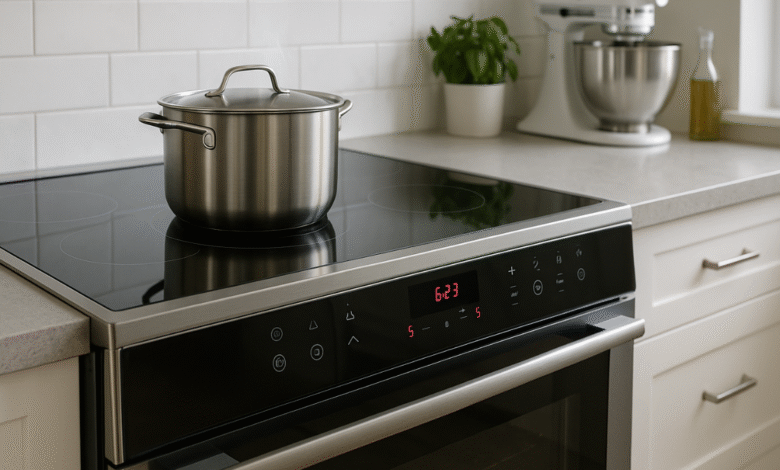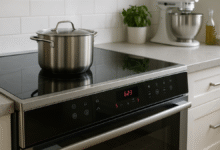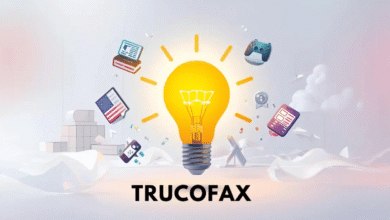Induction Range: A Complete Guide for Modern Kitchens

Discover the benefits of an induction range—fast heating, energy efficiency, safety, and smart features that make it the ultimate modern kitchen upgrade.
Introduction
An induction range is becoming a centerpiece in today’s modern kitchens. Unlike traditional gas or electric ranges, it uses advanced technology to heat food quickly and efficiently. Homeowners and chefs alike appreciate its sleek design, precise temperature control, and energy savings. As more people look for eco-friendly and convenient cooking solutions, it’s easy to see why the induction stove is rising in popularity.
How an Induction Range Works
At the heart of an induction range is magnetic field technology. Instead of heating the burner itself, the cooktop sends energy directly into the pan through electromagnetic currents. This means the pan heats up instantly while the surface of the cooktop stays relatively cool.
The difference between induction and traditional gas or electric ranges is clear. Gas relies on open flames, while electric ranges heat through coils. By contrast, induction transfers energy straight to the cookware, offering faster, more efficient results.
Benefits of an Induction Range
Faster Heating and Energy Efficiency
One of the standout features of induction cooking is how quickly it brings pots and pans to temperature. Boiling water or searing meat happens in a fraction of the time compared to other ranges. Many models are even ENERGY STAR certified, proving their ability to save on utility bills.
Safety Features
Parents love that the surface of an induction range stays cool to the touch. Auto shut-off functions add another layer of safety, making it one of the best options for families.
Precise Cooking Control
With settings that adjust in small increments, cooks can simmer sauces or melt chocolate without fear of burning. The accuracy rivals even professional-grade appliances like the 800 Series and KitchenAid models.
Easy to Clean and Maintain
The flat stovetop design makes cleanup a breeze. Spills don’t burn onto the glass surface, so a simple wipe with a damp cloth keeps the range looking new.
Potential Drawbacks to Consider
Higher Upfront Investment
Induction ranges are often more expensive than gas or electric options. However, many buyers see it as a long-term investment that pays for itself over time.
Cookware Compatibility Issues
Not all pots and pans work with induction. Cookware must be magnetic, so stainless steel and cast iron are good fits, while glass or aluminum may not work.
Slight Learning Curve
Since induction cooking behaves differently, some people need a short adjustment period. Once comfortable, though, users often prefer it to traditional methods.
Features to Look for When Buying
- Burner size and layout options: Choose a cooktop that matches your cooking habits, whether that’s multiple burners for family meals or a compact design for small kitchens.
- Power levels and smart technology: High-end models, like the Smart Slide-In Induction ranges, provide programmable cooking modes and Wi-Fi connectivity.
- Trusted brands and warranties: Companies such as KitchenAid and premium lines like the 800 Series offer strong reputations and reliable warranties.
Induction Range vs. Gas and Electric
Cooking Performance Comparison
Compared to gas, induction heats faster and provides more consistent results. Against electric, induction wins with its responsiveness and energy savings.
Cost Over Time
Although the initial purchase price is higher, reduced energy use and long lifespan balance the cost in the long run.
Environmental Impact
Since induction cooking is more efficient and often paired with eco-friendly features, it’s seen as a greener choice for modern households.
Best Uses & Ideal Buyers
Induction ranges are perfect for people who value safety, precision, and efficiency. Families with kids benefit from the cool-touch surfaces, while food lovers enjoy precise control. Busy households that want speed and convenience also find induction a great match.
Care and Maintenance Tips
- Use non-abrasive cleaners to avoid scratching the glass.
- Place protective mats or avoid dragging cookware across the surface.
- Always ensure pots and pans are induction-compatible for the best performance.
FAQs
Do induction ranges use more electricity than gas?
Not necessarily. They use electricity, but because they’re highly efficient, they often consume less overall energy than traditional gas cooking.
Can I use normal cookware on an induction range?
Only if it’s magnetic. To test, place a magnet on the bottom of your pan—if it sticks, it’s induction-ready.
Are induction ranges safer for families with kids?
Yes. Since the cooktop stays cool and includes features like auto shut-off, it’s one of the safest options available.
How durable are induction cooktops?
When cared for properly, they can last as long as gas or electric models. Premium ranges like the 800 Series are known for their durability.
Is switching to induction worth it long-term?
Absolutely. While the initial cost is higher, the benefits of efficiency, safety, and control make it a smart upgrade for most households.
Conclusion
An induction range combines innovation, safety, and convenience in one sleek package. From faster cooking times to precise control and easy cleaning, it has clear advantages over gas and electric models. Though it comes with a learning curve and higher upfront cost, the long-term benefits make it an excellent choice for anyone seeking a modern kitchen upgrade.





